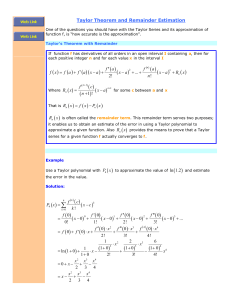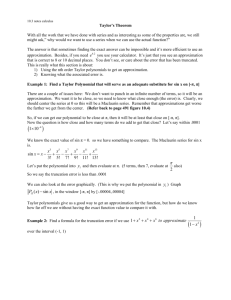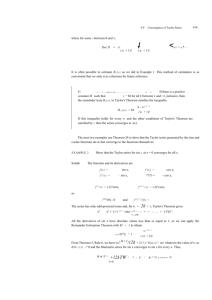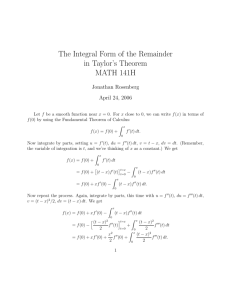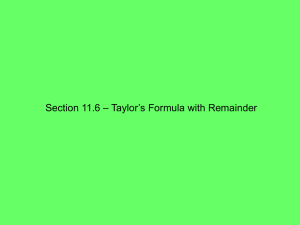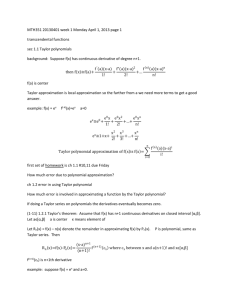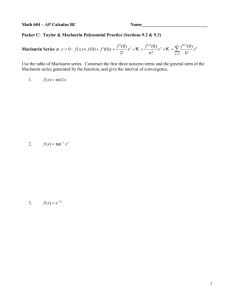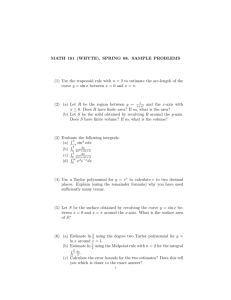9 - wellsclass
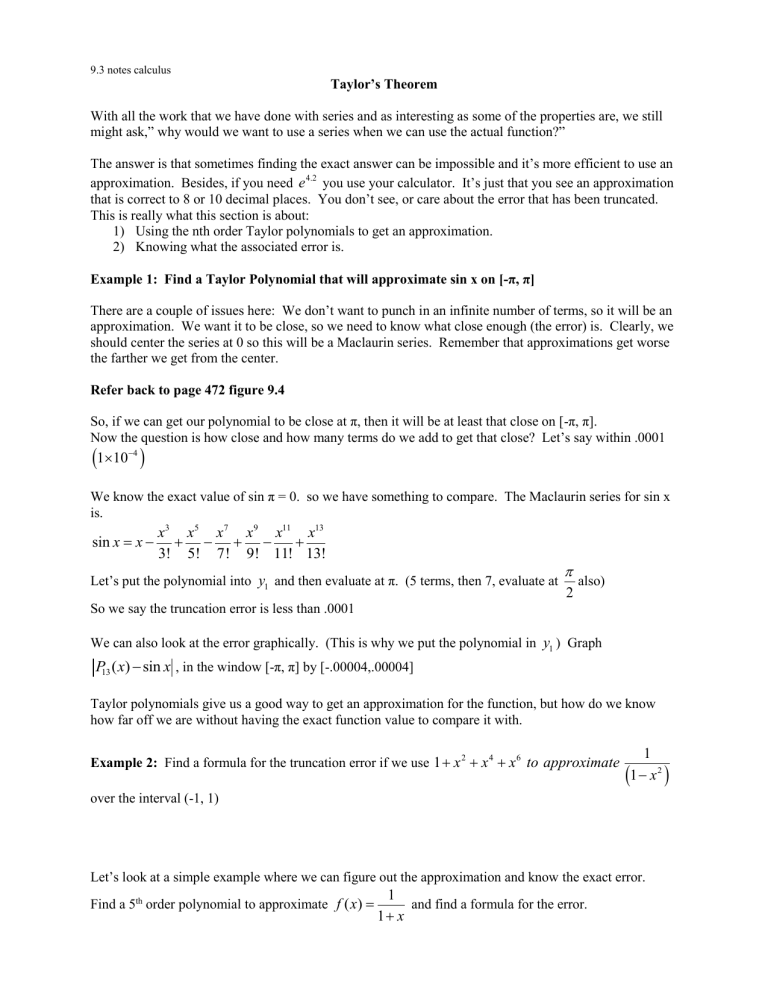
9.3 notes calculus
Taylor’s Theorem
With all the work that we have done with series and as interesting as some of the properties are, we still might ask,” why would we want to use a series when we can use the actual function?”
The answer is that sometimes finding the exact answer can be impossible and it’s more efficient to use an approximation. Besides, if you need
4.2
e you use your calculator. It’s just that you see an approximation that is correct to 8 or 10 decimal places. You don’t see, or care about the error that has been truncated.
This is really what this section is about:
1) Using the nth order Taylor polynomials to get an approximation.
2) Knowing what the associated error is.
Example 1: Find a Taylor Polynomial that will approximate sin x on [-π, π]
There are a couple of issues here: We don’t want to punch in an infinite number of terms, so it will be an approximation. We want it to be close, so we need to know what close enough (the error) is. Clearly, we should center the series at 0 so this will be a Maclaurin series. Remember that approximations get worse the farther we get from the center.
Refer back to page 472 figure 9.4
So, if we can get our polynomial to be close at π, then it will be at least that close on [-π, π].
Now the question is how close and how many terms do we add to get that close? Let’s say within .0001
4
We know the exact value of sin π = 0. so we have something to compare. The Maclaurin series for sin x is. sin x x x 3 x 5 x 7 x 9 x 11 x 13
3!
5!
7!
9!
11! 13!
Let’s put the polynomial into y and then evaluate at π. (5 terms, then 7, evaluate at
1
2
So we say the truncation error is less than .0001 also)
We can also look at the error graphically. (This is why we put the polynomial in y ) Graph
1
P x
13
x , in the window [-π, π] by [-.00004,.00004]
Taylor polynomials give us a good way to get an approximation for the function, but how do we know how far off we are without having the exact function value to compare it with.
Example 2: Find a formula for the truncation error if we use 1
2 4 6 x x x to approximate
1
1 x
2
over the interval (-1, 1)
Let’s look at a simple example where we can figure out the approximation and know the exact error.
Find a 5 th order polynomial to approximate
1
1
x
and find a formula for the error.
1
1
x
1 x x
2 x
4 x
5 x
6
.....
[ approximation ][ error ]
The error is geometric with r = -x so if we combine the terms from
5 x on we get E
x 5
1
x
If we increased the order of our polynomial we would decrease our error.
P n
n
1
x
x 5
1
x
We can graphically see the error decreasing by making y
1
P and y
5 2
1
1
x
or since we have the formula y
1
5
1
x
The previous problem was fairly simple, especially where finding the error was concerned. The error was the sum of an infinite geometric series, so we could say exactly what the error was. We would like to be able to do this even if the remainder is not geometric. Remember this section is about using polynomials to make approximations and about knowing what the error is. Luckily, Taylor has figured out both of these things for us.
Theorem 3: Taylor’s theorem with Remainder
If f has derivatives of all orders in an open interval I containing a , then for each positive integer n and for each x in I , f
( )
( )
( )
( )( a
2!
( x
a )
2 f ( )
( x
a ) n n
( ) n !
n
( n
1) f
n
( x
a ) n
1
For some c between a and x.
The first equation in Taylor’s Theorem is Taylor’s formula
.
The function n
( n
1) f
n
( x
a ) n
1 is the remainder of order n or the error term for the approximation of f by n
( ) over I. This is called the Lagrange form of the remainder and bounds on n
( ) found using this form are Lagrange error bounds .
With n
( ) gives us a mathematically precise way to define what we mean when we say that a Taylor series converges to a function on an interval. If n
( )
0 as n
for all x in I, we say that the
Taylor series generated by f at x = a converges to f on I, and we write
k
0 f ( ) k k !
If we can find a number that this error can’t exceed, we call it a Lagrange error bound. This leads to another more useful error theorem.
Theorem 4: Remainder Estimation Theorem
If there are positive constants M and r such that f
n
1
( )
Mr n
1
for all t between a and x, then the remainder n
( ) in Taylor’s Theorem satisfies the inequality n
( )
M r n
1 x
a
n
n
1
If these conditions hold for every n and all the other conditions of Taylor’s Theorem are satisfied by f, then the series converges to f(x).
In the error formula, the only real mystery is what the next derivative is and what the n+1 derivative is evaluated at some point between x and a. If we can find a bound for that, we’ve found a bound for the error…a Lagrange error bound.
Let’s use these ideas to do a simple problem and then one that’s not so simple.
Prove that k
0
k x
2 k
converges to cos(x) for all x.
For this to converge the remainder must always go to zero as the order of our polynomial goes to infinity.
The remainder for the nth order is: n
( n
1) f
n
( x
a ) n
1
This approximation is centered at 0 so a = 0. This means we have to pick a point between 0 and x to evaluate the n+1 derivative. This seems awful, but we can say something unique about the n+1 derivative. The most it can be is 1. So….
The error can’t be more than
1( x
0) n
1
( n
1)!
In notation n
1 x n
1
n
Then n
1 x n
1
n
0
Sometimes the derivative doesn’t work out as well so we have to use the formula to come up with a
Lagrange error bound.
Example 4 ( We are looking for Mr n
1
to be bigger than f
n
1
and we do this in a tricky way.
25.
A cubic Approximation of x e The approximation e x
1 x x 2 x 3
is used on small intervals
2 6 about the origin. Estimate the magnitude of the approximation error for x
0.1
12.
If cos x is replaced by 1
x
2
2
x
2 and x
1 tend to be too large or too small? Support your answer graphically.
2
0.5, what estimate can be made of the error? Does
